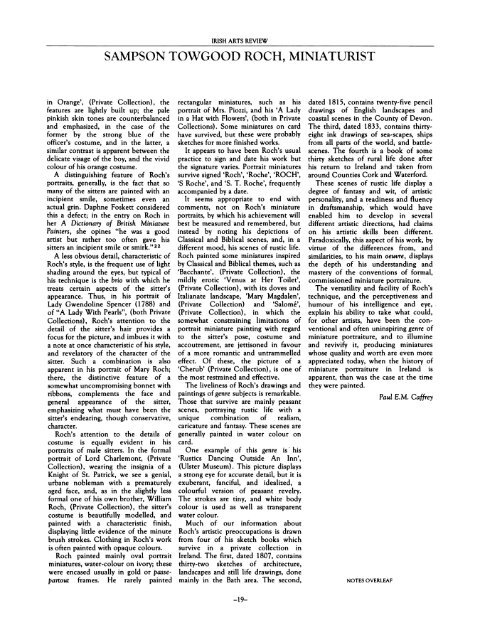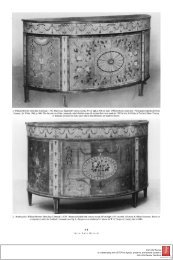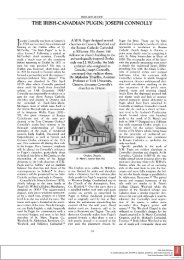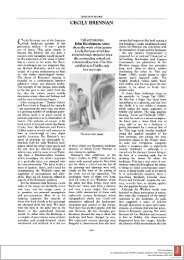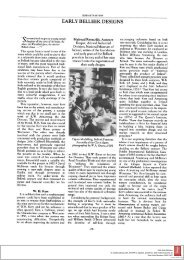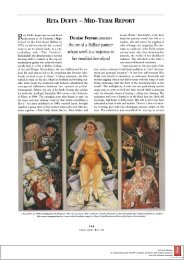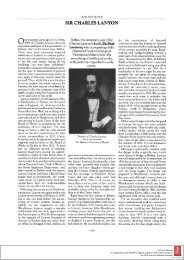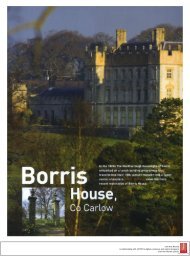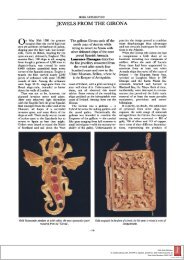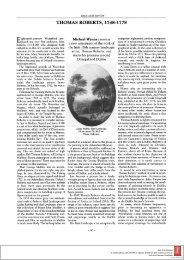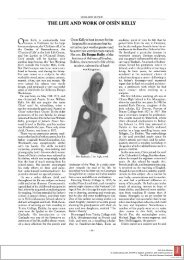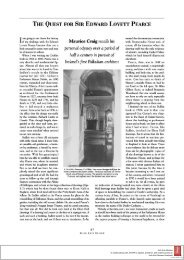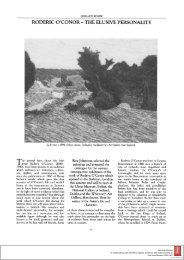SAMPSON TOWGOOD ROCH, MINIATURIST
SAMPSON TOWGOOD ROCH, MINIATURIST
SAMPSON TOWGOOD ROCH, MINIATURIST
Create successful ePaper yourself
Turn your PDF publications into a flip-book with our unique Google optimized e-Paper software.
IRISH ARTS REVIEW<br />
<strong>SAMPSON</strong> <strong>TOWGOOD</strong> <strong>ROCH</strong>, <strong>MINIATURIST</strong><br />
in Orange', (Private Collection), the<br />
features are lightly built up; the pale<br />
pinkish skin tones are counterbalanced<br />
and emphasized, in the case of the<br />
former by the strong blue of the<br />
officer's costume, and in the latter, a<br />
similar contrast is apparent between the<br />
delicate visage of the boy, and the vivid<br />
colour of his orange costume.<br />
A distinguishing feature of Roch's<br />
portraits, generally, is the fact that so<br />
many of the sitters are painted with an<br />
incipient smile, sometimes even an<br />
actual grin. Daphne Foskett considered<br />
this a defect; in the entry on Roch in<br />
her A Dictionary of British Miniature<br />
Painters, she opines "he was a<br />
good<br />
artist but rather too often gave his<br />
sitters an<br />
incipient smile or smirk."22<br />
A less obvious detail, characteristic of<br />
Roch's style, is the frequent use of light<br />
shading around the eyes, but typical of<br />
his technique is the brio with which he<br />
treats certain aspects of the sitter's<br />
appearance. Thus, in his portrait of<br />
Lady Gwendoline Spencer (1788) and<br />
of "A Lady With Pearls", (both Private<br />
Collections), Roch's attention to the<br />
detail of the sitter's hair provides<br />
a<br />
focus for the picture, and imbues it with<br />
a note at once characteristic of his style,<br />
and revelatory of the character of the<br />
sitter. Such a combination is also<br />
apparent in his portrait of Mary Roch;<br />
there, the distinctive feature of a<br />
somewhat uncompromising bonnet with<br />
ribbons, complements the face and<br />
general appearance of the sitter,<br />
emphasizing what must have been the<br />
sitter's endearing, though conservative,<br />
character.<br />
Roch's attention to the details of<br />
costume is equally evident in his<br />
portraits of male sitters. In the formal<br />
portrait of Lord Charlemont, (Private<br />
Collection), wearing the insignia of a<br />
Knight of St. Patrick, we see a genial,<br />
urbane nobleman with a<br />
prematurely<br />
aged face, and, as in the slightly less<br />
formal one of his own brother, William<br />
Roch, (Private Collection), the sitter's<br />
costume is beautifully modelled, and<br />
painted with a characteristic finish,<br />
displaying little evidence of the minute<br />
brush strokes. Clothing in Roch's work<br />
is often painted with opaque colours.<br />
Roch painted mainly oval portrait<br />
miniatures, water-colour on<br />
ivory; these<br />
were encased usually in gold<br />
or passe<br />
partout frames. He rarely painted<br />
rectangular miniatures, such as his<br />
portrait of Mrs. Piozzi, and his 4A Lady<br />
in a Hat with Flowers', (both in Private<br />
Collections). Some miniatures on card<br />
have survived, but these were probably<br />
sketches for more finished works.<br />
It appears to have been Roch's usual<br />
practice to sign and date his work but<br />
the signature varies. Portrait miniatures<br />
survive<br />
signed 'Roch', 'Roche', '<strong>ROCH</strong>',<br />
'S Roche', and 'S. T. Roche', frequently<br />
accompanied by a date.<br />
It seems appropriate to end with<br />
comments, not on Roch's miniature<br />
portraits, by which his achievement will<br />
best be measured and remembered, but<br />
instead by noting his depictions of<br />
Classical and Biblical scenes, and, in a<br />
different mood, his scenes of rustic life.<br />
Roch painted some miniatures inspired<br />
by Classical and Biblical themes, such as<br />
'Bacchante', (Private Collection), the<br />
mildly erotic 'Venus at Her Toilet',<br />
(Private Collection), with its doves and<br />
Italianate landscape, 'Mary Magdalen',<br />
(Private Collection) and 'Salom?',<br />
(Private Collection), in which the<br />
somewhat constraining limitations of<br />
portrait miniature painting with regard<br />
to the sitter's pose, costume and<br />
accoutrement, are<br />
jettisoned<br />
in favour<br />
of a more romantic and untrammelled<br />
effect. Of these, the picture of a<br />
'Cherub' (Private Collection), is one of<br />
the most restrained and effective.<br />
The liveliness of Roch's drawings and<br />
paintings of genre subjects is remarkable.<br />
Those that survive are<br />
mainly peasant<br />
scenes, portraying rustic life with a<br />
unique combination of realism,<br />
caricature and fantasy. These scenes are<br />
generally painted in water colour on<br />
card.<br />
One example of this genre is his<br />
'Rustics Dancing Outside An Inn',<br />
(Ulster Museum). This picture displays<br />
a strong eye for accurate detail, but it is<br />
exuberant, fanciful, and idealized, a<br />
colourful version of peasant revelry.<br />
The strokes are tiny, and white body<br />
colour is used as well as transparent<br />
water colour.<br />
Much of our information about<br />
Roch's artistic preoccupations is drawn<br />
from four of his sketch books which<br />
survive in a private collection in<br />
Ireland. The first, dated 1807, contains<br />
thirty-two sketches of architecture,<br />
landscapes and still life drawings, done<br />
mainly in the Bath area. The second,<br />
dated 1815, contains twenty-five pencil<br />
drawings of English landscapes and<br />
coastal scenes in the County of Devon.<br />
The third, dated 1833, contains thirty<br />
eight ink drawings of sea-scapes, ships<br />
from all parts of the world, and battle<br />
scenes. The fourth is a book of some<br />
thirty sketches of rural life done after<br />
his return to Ireland and taken from<br />
around Counties Cork and Waterford.<br />
These scenes of rustic life display<br />
a<br />
degree of fantasy and wit, of artistic<br />
personality, and a readiness and fluency<br />
in draftsmanship, which would have<br />
enabled him to develop in several<br />
different artistic directions, had claims<br />
on his artistic skills been different.<br />
Paradoxically, this aspect of his work, by<br />
virtue of the differences from, and<br />
similarities, to his main oeuvre, displays<br />
the depth of his understanding and<br />
mastery of the conventions of formal,<br />
commissioned miniature portraiture.<br />
The versatility and facility of Roch's<br />
technique, and the perceptiveness and<br />
humour of his intelligence and eye,<br />
explain his ability to take what could,<br />
for other artists, have been the con<br />
ventional and often uninspiring genre of<br />
miniature portraiture, and to illumine<br />
and revivify it, producing miniatures<br />
whose quality and worth are even more<br />
appreciated today, when the history of<br />
miniature portraiture in Ireland is<br />
apparent, than was the case at the time<br />
they<br />
were<br />
painted.<br />
NOTES OVERLEAF<br />
Paul E.M. Caffrey<br />
-19


